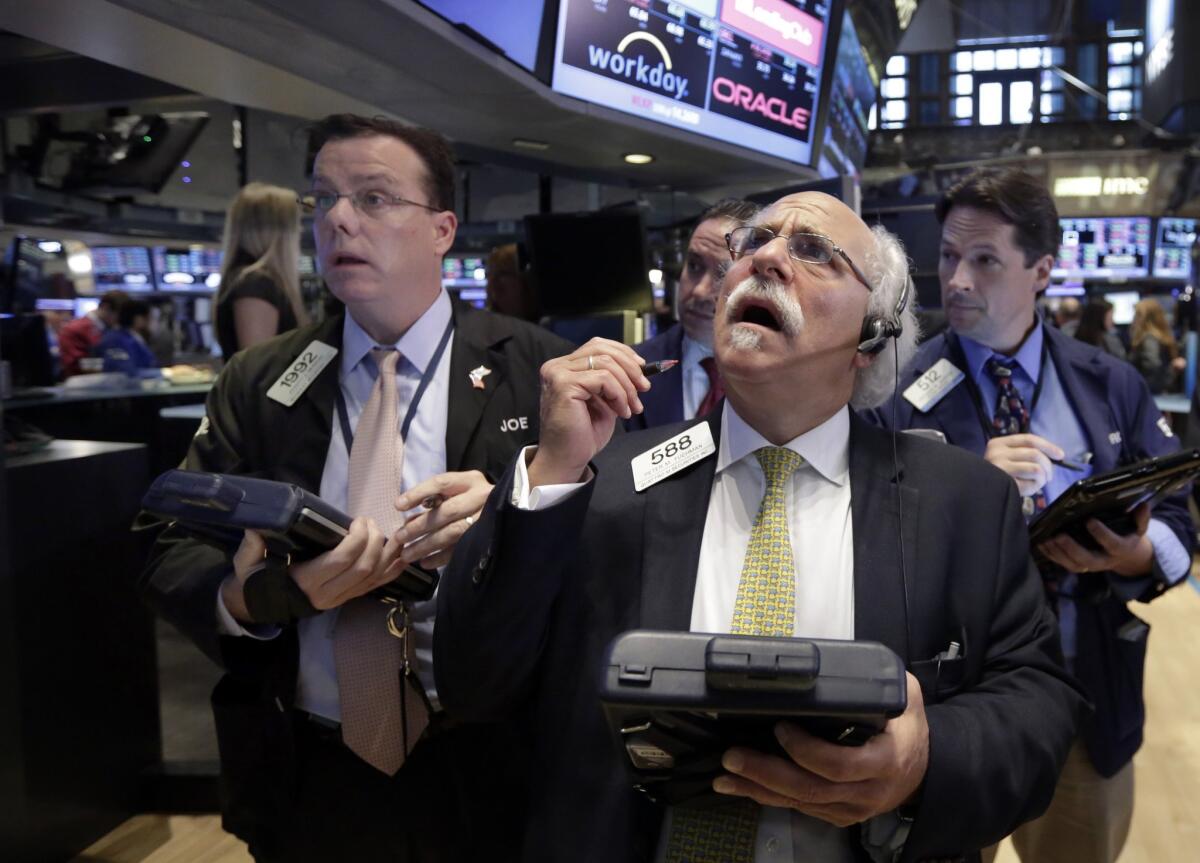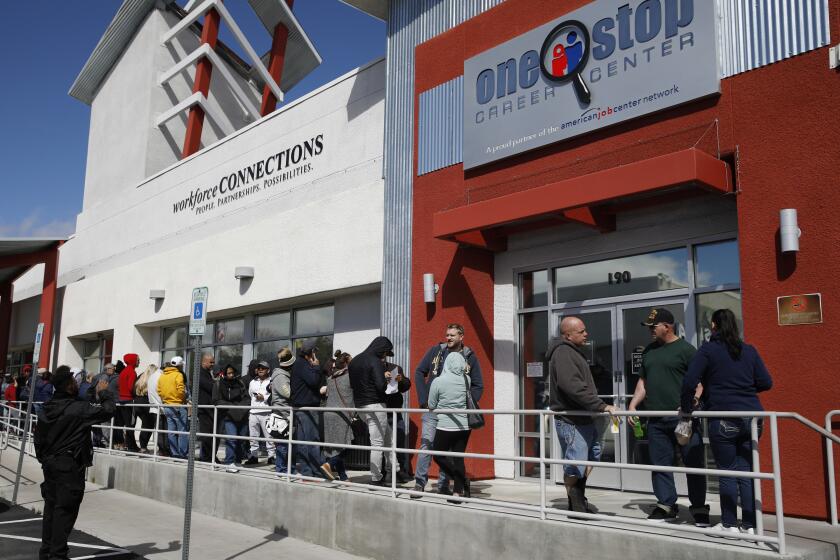Column: Why did the stock market rally on awful unemployment news?

- Share via
The stock market’s rally Thursday after the release of a truly gruesome unemployment number was taken widely as yet another indicator that Wall Street is a hive of callous profiteers.
This seemed to be true even among people who should know better. Ben White, who is the chief economic correspondent for Politico and a frequent guest on CNBC, expressed perplexity that the market hadn’t been seized by grief after the government’s announcement that 6.3 million workers had filed new unemployment claims in the last week.
“Has Wall Street gone crazy?” White tweeted, repeating the query in his Morning Money newsletter Friday. “The S&P just wrapped up its best week since 1974. We also learned this week that the Covid-19 virus has wiped out 17 million jobs in just three weeks, 10 percent of the entire America work force.”
We want lots of people to apply for benefits. The more the better.
— Kevin Drum, Mother Jones
The implication was that a rational, even tactful, stock market would have reacted to the unemployment figures like a mourner at a funeral, with bowed head and the wringing of hands. The idea seems to be that only a tide of red ink on the day would have shown that the stock market has a soul.
But that’s misguided on several counts. It ignores market psychology, market dynamics and market history. And it misunderstands what the unemployment figures are telling us. The truth is, they’re reason for optimism, not pessimism. more on that in a moment. (I don’t mean to pick on White, whose reporting is generally worth following.)
This is not to say that the stock market has necessarily returned to its bullish ways -- in coming weeks or months it could well test the coronavirus crash lows set March 23. That’s when the Dow Jones industrial average sank to 18,591, marking a 37% decline from its all-time peak in mid-February. The index has gained more than 27% since then, paring its overall loss to about 20%.
Nor does it mean we should be cold to the real damage done to individuals’ stock portfolios in the recent downturn, especially those belonging to retired or near-retired investors who’ve been counting on a buoyant stock market for sustenance. It certainly doesn’t mean we should be blind to the pain suffered by those thrown out of work and into unemployment by the virus-inspired economic shutdown.
Without minimizing the scale of the economic plunge, it’s proper to place comparisons between today’s figures and economic situation and those of the Depression in perspective. In short: The differences are greater than the similarities.
The point is that the stock market doesn’t care about your feelings. Nor should it. Individual investors are often guided by emotion, but the stock market is structured to neutralize the emotions of individual investors.
The stock market, in the aggregate, pays little attention to the present and almost none to the past. It looks to the future. Stock prices are an expression of investors’ expectations of how the economy will look next week, next month, next year and over the next decade or even longer.
We’ve been trained to think differently by the standard model of daily stock market coverage, in which every day’s action is almost invariably attributed to some news event of the moment. Here’s an Associated Press roundup from Jan. 17: “Global stock markets followed Wall Street higher on Friday after China reported 6.1% economic growth in 2019 and Washington and Beijing signed an interim trade agreement.”
It’s possible that these factors influenced stock trading -- briefly. But it’s not likely that they exerted enough influence to warrant their placement in the first paragraph. They’re in there, however, because business news editors demand that every day’s trading be explained somehow, preferably by an event occurring the same day.
Past bear markets bequeathed us a host of investment maxims (but they were often wrong).
I know this because I wrote not a few such articles in my days of stock market reporting. I knew it wouldn’t do to write: “The stock market rose [or fell] today because who the hell knows?” even though that would be close to the truth. Nothing like that would get into the paper.
It’s true that cataclysmic events are often reflected in major stock market downturns: assassinations of political leaders, 9/11, pandemics. But that’s not because the stock market is seized by grief. It’s because it’s seized by uncertainty.
No one can be sure what will happen in the wake of an attack on political leadership, or a large-scale terrorist attack, or the sudden emergence of a lethal pandemic, or how long the doubts will last.
The best explanation of market psychology I ever heard came from the late Michael Metz, who was a frequent source of mine in the 1980s, when he was chief investment strategist at Oppenheimer & Co. Metz explained that the stock market declined in times of uncertainty about the economy, and rose when the uncertainty was dispelled -- and it would rise whether investors became certain that the economy was about to boom, or when it was about to bust.
That should help us understand why the market rallied upon the release of unemployment figures Thursday. (The Dow and Standard & Poor’s 500 indices also rallied on April 2, when the government announced 6.6 million new unemployment filings, and even more on March 26, when the government reported 3.3 million new claims.)
To begin with, the unemployment filings removed all uncertainty that the economy is in for a rough few weeks or months. The market in the aggregate takes that as a positive because it’s likely to inspire ever more aggressive stimulus by Congress and the Federal Reserve, which already have pumped trillions into the economy.
It’s time to think about how to get workers raises over the long term.
The signs are that the investment community, if we draw a line from the stock market’s action, understands that this unemployment surge is qualitatively different from what would be seen in a downturn caused by economic fundamentals, such as the downturns of 1999-2000 and 2008-2009 or, for that matter, the Great Depression.
This one is artificial. It’s caused not by economic shortcomings but a deliberate cessation of economic activity to combat a public health threat. Under the circumstances, the surge in unemployment filings is a sign that government policy has been a success, not failure.
The whole point of the congressional enactment of sharply higher unemployment benefits for the next few months -- so high, indeed, that lower-income workers will collect more from unemployment than they were earning on the job -- was to persuade people to stay home instead of going to work and spreading the virus if they could, and to sustain them if they had no choice.
“We want lots of people to apply for benefits,” observed Kevin Drum of Mother Jones. “The more the better.”
The real lesson of the recent action is that sometimes the stock market -- again, in the aggregate -- sees something that eludes the rest of us on the spot. The best illustration of that may be an incident from 1983.
That’s when Charles Bluhdorn, whose creation of the giant conglomerate Gulf & Western had made him an iconic business leader, died of a heart attack while on a cross-country flight on his private plane.
The story goes that some of the executives aboard the flight took advantage of their inside knowledge to sell Gulf & Western shares before news of Bluhdorn’s death became public. This may be apocryphal. What isn’t, however, is that the market confounded everyone who assumed that the loss of its leader would send Gulf & Western shares spiraling down.
Instead, the shares took off, gaining nearly 30% in the first week after Bluhdorn’s death. The perception on Wall Street, it turned out, was that the company’s parts were worth more than the whole, and with Bluhdorn gone it could be broken up to capture all that imprisoned value.
Wall Street was right then, though that doesn’t mean it’s correct now. After all, two of the market’s best years were 1933 and 1935, when it gained more than 50% both years, during a long slide that cut share values by 90%. Prices did not return to their pre-1929 values for 25 years.
The point is that while sometimes the stock market will fool you, it’s never wise to treat it as a moral barometer. Or, for that matter, a repository of emotion and sentiment. If you’re expecting sympathy and empathy from the Dow Jones industrial average, you’re looking in the wrong place.
More to Read
Inside the business of entertainment
The Wide Shot brings you news, analysis and insights on everything from streaming wars to production — and what it all means for the future.
You may occasionally receive promotional content from the Los Angeles Times.













